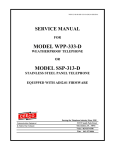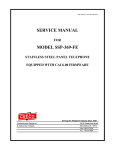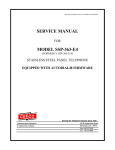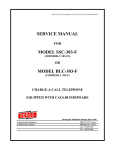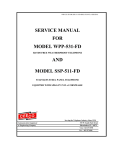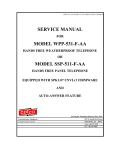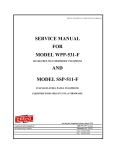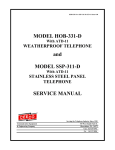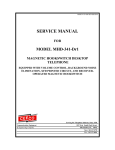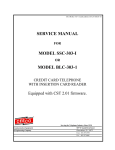Download CEECO BLC-303-1 Service manual
Transcript
SSC OR BLC-303-1 (306-I)-CST2.01-ISSUE 4.0 SERVICE MANUAL FOR MODEL SSC-303-I OR MODEL BLC-303-1 (FORMERLY 306-I) CHARGE A CALL TELEPHONE WITH INSERTION CARD READER Equipped with CST 2.01 firmware. Serving the Telephone Industry Since 1930 Communication Equipment & Engineering Company 519 W South Park Street Okeechobee, FL 34972 Voice: 863-357-0798 Fax: 863-357-0006 Issue 4.0 IMPORTANT INFORMATION FOR CUSTOMER Please fill in before you continue. The following information is necessary when calling CEECO for assistance. MODEL NUMBER MODEL SSC OR BLC-303-I EQUIPPED WITH CST2.01 FIRMWARE (FORMERLY 306-I) SERIAL NUMBER DATE MANUFACTURED LOCATION INSTALLED For us to better serve you, please have this information available when calling for technical support. CEECO Communication Equipment & Engineering Company 519 W South Park Street Okeechobee, FL 34972 863-357-0798- telephone 863-357-0006- facsimile [email protected] www.ceeco.net CEECO Communication Equipment and Engineering Company PROPRIETARY 2 Issue 4.0 TABLE OF CONTENTS SECTION PAGE 1.0 INTRODUCTION............................................................................................................................ 4 2.0 GENERAL........................................................................................................................................ 4 3.0 PROGRAMMING ........................................................................................................................... 5 PROGRAMMING CONTINUED… ............................................................................................... 6 PROGRAMMING CONTINUED................................................................................................... 7 PROGRAMMING CONTINUED................................................................................................... 8 PROGRAMMING CONTINUED................................................................................................... 8 4.0 PROGRAMMING TABLES........................................................................................................... 9 PROGRAMMING TABLES CONTINUED ................................................................................ 10 PROGRAMMING TABLES CONTINUED ................................................................................ 12 5.0 OPERATION ................................................................................................................................. 13 6.0 CARD CALLING........................................................................................................................... 13 7.0 SPECIFICATIONS........................................................................................................................ 14 8.0 PARTS LIST .................................................................................................................................. 15 9.0 RECOMMENDED TOOLS AND TEST EQUIPMENT............................................................ 15 10.0 INSTALLATION NOTES AND ASSEMBLY INSTRUCTIONS............................................. 16 11.0 TROUBLESHOOTING ................................................................................................................ 17 TROUBLESHOOTING CONTINUED ....................................................................................... 18 12.0 FCC NOTICE................................................................................................................................ 19 13.0 REPAIR AND RETURN INFORMATION ............................................................................... 20 14.0 WARRANTY POLICY ................................................................................................................ 21 15.0 LOCATION OF PROGRAMMING JUMPERS ...................................................................... 22 CEECO Communication Equipment and Engineering Company PROPRIETARY 3 Issue 4.0 1.0 INTRODUCTION The practices in this manual provide installation and maintenance information for the CEECO Model SSC OR BLC-303-I Charge-A-Call Telephone with Insertion Card Reader (formerly 306-I) and firmware CST2.01. The information in this manual is subject to change without notification. For information not included in this manual, please call or write: CEECO Customer Service 519 W South Park Street Okeechobee, FL 34972 863-357-0798- telephone 863-357-0006- facsimile [email protected] www.ceeco.net 2.0 GENERAL The CEECO Model 303-I Charge-A-Call Telephone is a microprocessor-based, line powered instrument designed to read the information encoded on the magnetic strip of any ABA Track-2 credit card, and transmit the data via DTMF tones. This model is compatible with the AT&T/BOC, TSPS "Calling Card Service" (CCS) systems and the Southlake Technologies or Summa-Four Call Processors. Software protocol must be specified when ordering. NOTE: Before installing the phone, please read; Section 10.0 Installation Notes. CEECO Communication Equipment and Engineering Company PROPRIETARY 4 Issue 4.0 3.0 PROGRAMMING 3.1 Using a security tool, remove the backplate and locate the Printed Circuit Board. Locate the two plastic mini-jumpers on the Printed Circuit Board. With the phone on hook, place the two mini-jumpers in the "ON" position, as depicted in the diagram on the last page of this manual. 3.2 Take the phone off hook. if you are programming the phone for the first time, clear all field programmable memory by dialing #97. 3.3 Each location is accessed by dialing #XX, where XX is a two (2) digit code from 00 to 97. The previous contents of the location are automatically erased when the location is dialed. 3.4 In location #18 enter the default call processor number. If the dial-up number is a C.O. speed dial number, enter the "*" key in place of the "#" (i.e. to send 22#, enter 22*). Leave this location blank if no call processor is used. 3.5 In location #19 enter the P.B.X access code, if any (i.e. 9). 3.6 In location #20, enter the phone I.D. (up to 11 digits). Required only for use with Call Processors. 3.7 If Charge-A-Call restrictions by the phone are necessary, enter the allowable numbers in the free call index (location #70 - #79). EXAMPLE: #70 #71 #72 #73 #74 #75 (NOTE: "-" Shown for clarity only.) 0-***-***-**** (allows all 0-, 0+ calls) *11 (allows 911, 411, 611, etc.) 1-555-1212 1-***-555-1212 1-800-***-**** 950-****-**** (allows all 950 exchange numbers) NOTE: Each location is up to eleven digits in length. To allow additional digits to be dialed, fill the remaining spaces with "*"s. EXAMPLE: #75 950-**** will not allow digits to be dialed after reaching the OCC. 950-****-**** will allow unlimited dialing after the OCC call has been completed. To disable all phone implemented call restrictions enter eleven "*"s in one of the free call index locations. CEECO Communication Equipment and Engineering Company PROPRIETARY 5 Issue 4.0 PROGRAMMING CONTINUED… 3.8 Now it is time to enter credit card handling data (See section 4.03 for blank tables.). For each different type of credit card three locations must be programmed. Three interactive tables are set up for the three different data types. Locations #21-#29 are for the Protocol table. Locations #51-#59 are for the Card Type Identifier table. Locations #61-#69 are for the POP number table. When entering the data for a particular card the three locations used must have the same digit in the ones column. EXAMPLE: LOCATION DATA 21 3 51 855 61 DESCRIPTION AT&T Card to TSPS AT&T Card Type Identifier. No Processor Number. 22 52 62 0 660032 888-888-8888 MCI Protocol. MCI Card Type Identifier. MCI Call Processor Number. 23 53 63 7 6600 BOC Card to TSPS. All Other BOCS to TSPS. No Processor Number. 27 57 67 Etc... 2 660030 999-999-9999 ITT Protocol. ITT Card Type Identifier. ITT Call Processor Number. The protocols available at this time are: NUMBER ENTERED 0 1 2 3 4 5 6 7 PROTOCOL TYPE MCI Dump card data and phone ID. (testing) ITT AT&T to TSPS SPRINT Dump full card data. (testing) 3 error tones and reset phone. BOC cards to TSPS. CEECO Communication Equipment and Engineering Company PROPRIETARY 6 Issue 4.0 PROGRAMMING CONTINUED Be sure to record the Protocol numbers entered from the previous page into the Protocol table locations #21-#29 on page 10 for future reference. Also record the Card Type Identifiers in the Card Type Identifier Table locations #51-#59. When entering numbers in the Card Type Identifier table, if you are using identifiers that have similar beginning digits, you must enter them according to their digit length. Place the longer length numbers first. Record the POP numbers in the POP Table locations #61- #69. EXAMPLES: WRONG WRONG DIGIT LENGTH Loc. |1|2|3|4|5|6|7| #51 |8|5|5| | | | | AT&T #52 |6|6|0|0| | | | ALL BOCS #53 |6|6|0|0|3|0| | ITT #54 |6|6|0|0|3|2| | MCI #55 |6|6|0|0|1|5| | WIS BELL Similar beginning digits. DIGIT LENGTH |1|2|3|4|5|6|7| |8|5|5| | | | | AT&T |6|6|0|0|3|0| | ITT |6|6|0|0|3|2| | MCI |6|6|0|0| | | | ALL BOCS |6|6|0|0|1|5| | WIS BELL Similar beginning digits. RIGHT DIGIT LENGTH Loc. |1|2|3|4|5|6|7| #51 |8|5|5| | | | | AT&T #52 |6|6|0|0|3|0| | ITT #53 |6|6|0|0|3|2| | MCI #54 |6|6|0|0|1|5| | WIS BELL #55 |6|6|0|0| | | | ALL BOCS Similar beginning digits. The first example is wrong because location 52 would cause the phone to match ITT, MCI and WIS BELL with the protocol for all BOCS. The second example is wrong because location 54 would cause the phone to match a WIS BELL card to the protocol for all other BOC cards. Notice, in the last example, that even though the AT&T number, in location 51, is shorter then the numbers that follow it the right protocol is selected because the beginning digits are different. Be sure that you adjust the other tables if you have already entered data in them. CEECO Communication Equipment and Engineering Company PROPRIETARY 7 Issue 4.0 PROGRAMMING CONTINUED 3.9 Location #00 is the option number, by entering 0 or 1 into each of the 8 digit locations below, the phone is customized to each particular installation. LOCATION #00: Digit 1: 0 No incoming calls allowed. 1 Incoming calls allowed. Digit 2: 0 Call restrictions are in effect. (#70-#79 only.) 1 No call restrictions. Digit 3: 0 All calling cards are allowed. 1 All calling cards are blocked. Digit 4: 0 Memory inspection disabled. 1 Memory inspection enabled. Digit 5: 0 Send expiration date of Bank Cards mm/yr (i.e. AT&T as long distance carrier). 1 Do not send expiration date of Bank Cards (i.e. MCI as long distance carrier). Digit 6: 0 Send only credit card numbers. 1 Send all credit card information on Track 2 (for use with a Call Processor). Digit 7: 0 Always 0 for Insertion type card reader. Digit 8: 0 Wide dial tone detect window. 1 Narrow dial tone detect window. 3.10 Locations #31-#50 are for the Speed Dial Table. Up to eleven digits may be entered in each location. Enter # followed by the location number and the number to be speed dialed from the keypad. 3.11 When programming is completed, place the two mini-jumpers in the "OFF" position, replace and secure the backplate, and place the phone on hook. PROGRAMMING CONTINUED CEECO Communication Equipment and Engineering Company PROPRIETARY 8 Issue 4.0 3.12 If you have a DTMF test set and you want to inspect any memory location you must have location #00 digit 4 set to a "1". Then simply enter the # key followed by the two digit code for the memory location to be inspected. The information stored in that memory location should appear on your test set. 3.13 To change a single memory location, place the phone on hook and place the two mini-jumpers in the "ON" position. Take the phone off hook, enter # plus the corresponding two digit code for that memory location, and enter the new numbers. Hang the phone up and place the two mini-jumpers in the "OFF" position. 3.14 Summary of programming locations: LOCATION #00 #18 #19 #20 #21 - #29 #30 - #49 #51 - #59 #61 - #69 #70 - #79 #97 4.0 DESCRIPTION SAMPLE ENTRY Option Number Default Call Processor P.B.X. Access Code Phone I.D. Number Card Protocol Code Speed Dial Numbers Card Type Identifiers POP Numbers For Each Card Type Free Call Index Clear All Programmable Memory 10110000 555-1212 9 1234567 3 444-4444 660015 950-5555 911 N/A PROGRAMMING TABLES 4.0 OPTION TABLE CODE #00 DESCRIPTION _________ Digit 1 2 3 4 5 6 7 8 9 PROGRAMMING TABLES CONTINUED 4.2 IDENTIFICATION TABLE CEECO Communication Equipment and Engineering Company PROPRIETARY 9 Issue 4.0 CODE DESCRIPTION #18 _-___-___-____ DEFAULT CALL PROCESSOR NUMBER (enter 1 to 11 digits) #19 _-___-___-____ PABX ACCESS CODE (enter 1 to 11 digits) #20 _-___-___-____ PHONE ID NUMBER (enter 7 to 11 digits) 4.3 PROTOCOL SELECTION, CARD TYPE IDENTIFIERS AND POP NUMBERS Code Protocol Selected #21 _ (1 digit) Code Card type ID Code POP _________ (notes) #51 _____________ (up to 11 digits) #61 ______________ (up to 11 digits) #22 _ _________ #52 _____________ #62 ______________ #23 _ _________ #53 _____________ #63 ______________ #24 _ _________ #54 _____________ #64 ______________ #25 _ _________ #55 _____________ #65 ______________ #26 _ _________ #56 _____________ #66 ______________ #27 _ _________ #57 _____________ #67 ______________ #28 _ _________ #58 _____________ #68 ______________ #29 _ _________ #59 _____________ #69 ______________ PROGRAMMING TABLES CONTINUED 4.4 SPEED DIAL TABLE CEECO Communication Equipment and Engineering Company PROPRIETARY 10 Issue 4.0 CODE DESCRIPTION CODE DESCRIPTION #30 _-___-___-____ #40 _-___-___-____ #31 _-___-___-____ #41 _-___-___-____ #32 _-___-___-____ #42 _-___-___-____ #33 _-___-___-____ #43 _-___-___-____ #34 _-___-___-____ #44 _-___-___-____ #35 _-___-___-____ #45 _-___-___-____ #36 _-___-___-____ #46 _-___-___-____ #37 _-___-___-____ #47 _-___-___-____ #38 _-___-___-____ #49 _-___-___-____ #39 _-___-___-____ CEECO Communication Equipment and Engineering Company PROPRIETARY 11 Issue 4.0 PROGRAMMING TABLES CONTINUED 4.5 FREE CALL TABLE CODE DESCRIPTION CODE DESCRIPTION #70 _-___-___-____ #75 _-___-___-____ #71 _-___-___-____ #76 _-___-___-____ #72 _-___-___-____ #77 _-___-___-____ #73 _-___-___-____ #78 _-___-___-____ #74 _-___-___-____ #79 _-___-___-____ EXAMPLES OF CALL RESTRICTIONS/ALLOWED CALLS (950-***-****-* allows access to 950 exchange numbers) (1-800-***-****) 1-***-555-1212 interlata directory assistance) (1-555-1212 intralata directory assistance) (*11 allows 411, 911, 011, etc.) (0-***-*-**-**** allows all 0-,0+,and calling cards) CEECO Communication Equipment and Engineering Company PROPRIETARY 12 Issue 4.0 5.0 OPERATION 5.1 The phone is taken off hook. 5.2 If location #19 contains a number, the phone will wait for dial tone, then dial the number entered in location #19. This is the PABX Access Number. If you do not want a PABX number dialed then leave location #19 blank. 5.3 Three modes of operation exist at this time: a. b. c. 6.0 Dial a free call; 911, 411 only if number resides in free-call table (4.05) Dial 0+ the number desired, wait for the tone, then insert/withdraw credit card. Enter a Help Selection only if your call processor offers this feature. CARD CALLING 6.1 If a valid Credit Card read was performed, a verifier beep will be heard. The phone will determine which type of card was read and what Protocol to use. 6.2 If AT&T cards are programmed to be blocked, 3 error tones will be heard and the phone will reset itself for another call. 6.3 If the call is to go to TSPS, the phone will wait for the user to dial a 0+ number. At the bong tone, the phone will send the card data. 6.4 If the call is to go to the Call Processor, the phone will dial the Call Processor. When the Call Processor acknowledges, the phone will send the phone I.D. and credit card information. The phone is now open. (Card reader on, keypad on, transmitter on, no call restrictions in effect.) 6.5 FREE CALLS. If the user attempts to dial a call not programmed in the free call index (call restrictions enabled), the phone will give three warning tones to the user, go on hook, and reset for another call attempt. CEECO Communication Equipment and Engineering Company PROPRIETARY 13 Issue 4.0 7.0 SPECIFICATIONS INPUT POWER C.O. Line powered LOOP CURRENT 23 mA min., 80 mA max. IMPEDANCE 600 ohms SIGNALING DTMF, 70ms Tone, 70 ms Spacing OUTPUT -4 to -6 dBm HEARING AID COMPATIBLE Meets EIA standards ENVIRONMENTAL Temperature: 0°C to 50°C Humidity: 20% to 90% non-condensing RINGER EQUIVALENCY 0.8A PROGRAMMING Via unit keypad TELEPHONE PANEL Brushed 16-gauge stainless steel DIMENSIONS 5∀ wide x 10 3/4∀ high x 5½” deep Handset on hook MOUNTING Vertical surface mount MEMORY RETENTION Lithium battery, long life FCC REGISTRATION BW88T7-13823-TE-T UL LISTED NO. 6OF5 TYPE JACK RJ11C CARD READER Protocol Capacity Speed Life Insertion Type, Read Only ABA Track-2, 1S02 40 characters 8-150 cm/sec 500,000 reads min. POP PROTOCOLS SUPPORTED Southlake Technologies Summa-Four AT&T "Calling Card System" (CCS) MCI ITT TSPS SPRINT BOC Cards to TSPS Custom Programming on Special order CEECO Communication Equipment and Engineering Company PROPRIETARY 14 Issue 4.0 8.0 9.0 PARTS LIST DESCRIPTION Hookswitch Cradle Tongue & Bracket Assembly Handset w/Armored Cord Network Network Cable Assembly Ringer MCRK-2 PC Board Assembly Chrome ANS Keypad Keypad Cable Modular Line Cord #10-32 Security Screws (2 ea.) Card Reader Assembly Card Reader Cable Instruction Card Kit Number Window Number Card Backplate Grommet Modular Connector (RJ11C) Handset Swivel CTA Board PART NO. 301-588 301-581 301-004 301-009 650-570 401-009 650-540 705-110 700-005 301-018 321-016 306-600 306-034 301-030 301-039 301-040 301-051 301-052 301-054 308-016 917-006 OPTIONAL: Security Tool GTE Logo 301-037 301-041 RECOMMENDED TOOLS AND TEST EQUIPMENT Volt/Ohm Meter 3/8∀ Nut Driver Security Tool, CEECO Part Number 301-037 Flat Blade Screw Driver DTMF Test Set CEECO Communication Equipment and Engineering Company PROPRIETARY 15 Issue 4.0 10.0 INSTALLATION NOTES AND ASSEMBLY INSTRUCTIONS 10.1 The use of a gas tube station protector is recommended. The station ground should not exceed 50 ohms. 10.2 To connect the phone to a phone line, plug the modular line cord from the phone unit into any RJ11C receptacle. 10.3 To access the inside of the phone for programming or service, remove the security screws on the sides and loosen the locking rod on the front using a 301-037 Security Tool. Slowly lift the cover, taking care not to damage the cables connecting the keypad and card reader to the MCRK-2 PC Board inside the phone. 10.4 The cover assembly may be separated from the base by disconnecting one end of each cable from the MCRK-2 PC Board. 10.5 When servicing the MCRK-2 board, be sure the board does not contact metal parts, otherwise permanent damage may occur to the board. ***** WARNING ***** A. Never install telephone wiring during a lightning storm. B. Never install telephone jacks in wet locations unless the jack is specifically designed for wet locations. C. Never touch uninsulated telephone wires or terminals unless the telephone line has been disconnected at the network interface. D. Use caution when installing or modifying telephone lines. CEECO Communication Equipment and Engineering Company PROPRIETARY 16 Issue 4.0 11.0 TROUBLESHOOTING Always visually check the phone for loose or shorted wires, damaged terminals or damaged parts. PROBLEM: NO DIAL TONE AND/OR MCKR-2 CARD DOES NOT FUNCTION POSSIBLE CAUSE: LINE CORD RJ11C CONNECTOR MCRK-2 CARD NETWORK NETWORK CABLE ASSY HOOKSWITCH CABLE ASSY HOOKSWITCH ASSY MICRO-PROCESSOR HANDSET PROBLEM: DIAL TONE IS DISTORTED POSSIBLE CAUSE: NETWORK CABLE ASSY HOOKSWITCH CABLE ASSY HOOKSWITCH ASSY MCRK-2 CARD NETWORK HANDSET PROBLEM: PHONE DOES NOT READ CARD POSSIBLE CAUSE: CARD DIRTY READ HEAD CARD READER CARD READER CABLE MCRK-2 CARD PROBLEM: TRANSMITTER DOES NOT TURN ON POSSIBLE CAUSE: HANDSET MCRK-2 CARD NETWORK CABLE ASSY NETWORK CEECO Communication Equipment and Engineering Company PROPRIETARY 17 Issue 4.0 TROUBLESHOOTING CONTINUED PROBLEM: TRANSMITTER DOES NOT TURN ON FOR INCOMING CALLS POSSIBLE CAUSE: IMPROPER OPTION NUMBER, CHANGE FIELD #00 DIGIT 1 TO A "1" MCRK-2 CARD PROBLEM: KEYPAD DOES NOT OPERATE PROPERLY POSSIBLE CAUSE: KEYPAD CABLE ASSY. KEYPAD MCRK-2 CARD PROBLEM: PHONE DOES NOT RECOGNIZE CALL PROCESSOR TONE OR BONG TONE POSSIBLE CAUSE: MCRK-2 CARD NETWORK NETWORK CABLE ASSY. PROBLEM: LOOSES MEMORY CONTENTS AFTER EXTENDED PERIODS OF NO USE POSSIBLE CAUSE: LITHIUM BATTERY PROBLEM: PHONE CANNOT BE PROGRAMMED POSSIBLE CAUSE: MINI-JUMPERS MISPLACED MEMORY CHIP MCRK-2 CARD KEYPAD KEYPAD CABLE ASSY. PROBLEM: RINGER DOES NOT OPERATE POSSIBLE CAUSE: RINGER NETWORK CEECO Communication Equipment and Engineering Company PROPRIETARY 18 Issue 4.0 12.0 FCC NOTICE 12.1 FCC REGISTRATION AND REPAIR INFORMATION Your new telephone has been registered with the Federal Communication Commission (FCC) in accordance with Part 68 of it's rules. The FCC requires that you be advised of certain requirements involving the use of this telephone. 12.2 CONNECTION AND USE WITH THE NATIONWIDE TELEPHONE NETWORK. The FCC requires that you connect this telephone to the Nationwide Telephone Network through a registered jack provided by the telephone company in your area. This jack is a modular outlet which you can order from your local telephone company. 12.3 NOTIFICATION TO THE TELEPHONE COMPANY Before connecting this telephone, the FCC requires that you notify your local telephone company business office. The number is in the front of your phone book. Tell them: The "line" to which you will connect the telephone (that is, your phone number), the telephone's FCC registration number and ringer equivalence number. These numbers are listed in section 7.0 The FCC further requires that you notify your local telephone company when permanently disconnecting this telephone. CEECO Communication Equipment and Engineering Company PROPRIETARY 19 Issue 4.0 13.0 REPAIR AND RETURN INFORMATION 13.1 WARRANTY REPAIR Any device returned requiring warranty service, repair or credit must be accompanied with a "Return Material Authorization" (RMA) FORM. It must include: return shipping instructions, original purchase order number and special marking instruction. A description of the trouble observed must be attached to the defective unit. This information must be inside the shipping container. 13.2 DIRECT ALL INQUIRES TO: CEECO Repair Department 863-357-0798- telephone 863-357-0006- facsimile [email protected] www.ceeco.net 13.3 NON-WARRANTY REPAIR CEECO will repair equipment out of warranty for a set charge plus parts. The customer must pay the shipping costs for both directions. 13.4 RETURN FOR CREDIT Material may be returned for credit only with prior approval. Material authorized for return is subject to a 20% restocking charge based on the manufacturers list price. Return Material Authorization must be requested no later than 30 days after original shipment. 13.5 EXCHANGE POLICY If a replacement unit is required it will be shipped in the most expedient manner consistent with the urgency of the situation. Please contact "Customer Service" for instructions regarding exchange of modules or printed circuit boards. CEECO Communication Equipment and Engineering Company PROPRIETARY 20 Issue 4.0 14.0 WARRANTY POLICY 14.1 GENERAL CEECO products are guaranteed to be free of defects in material and workmanship for a period of 365 days from the date of original purchase. CEECO’s obligation under this warranty is limited to repair or replacement of any part found to be defective by CEECO. Under no circumstances shall CEECO be liable for loss, damage, cost of repair, or consequential damages of any kind which have been caused by neglect, abuse, acts of GOD or improper of equipment. 14.2 PRINTED CIRCUIT BOARDS Printed circuit boards should not be field repaired. If a unit is found to be faulty, replace it with another unit and return the faulty unit to CEECO for repair. Modifications by anyone other than CEECO will void the warranty. CEECO Communication Equipment and Engineering Company PROPRIETARY 21 Issue 4.0 15.0 LOCATION OF PROGRAMMING JUMPERS Locate the mini jumpers on the corner of the PCB. ON F OF Move the mini jumpers to the ON position BEFORE going off-hook. When programming is completed, move the mini jumpers to the OFF position. ON F OF ON F OF NOTE: Do not leave the mini jumpers in the ON position, this will decrease battery life. CEECO Communication Equipment and Engineering Company PROPRIETARY 22






















